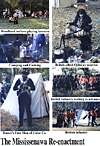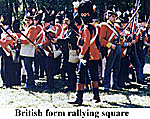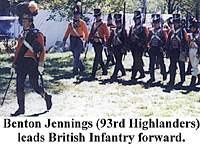 It took some time for me to pronounce it correctly and then it took some years for me to eventually participate in the event but I finally managed both.
It took some time for me to pronounce it correctly and then it took some years for me to eventually participate in the event but I finally managed both.
Large Re-enactment Photo 1 (slow: 146K)
Mississenawa has been one of those events that I had heard about for some time, its reputation having filtered down the re-enactor's grapevine for a few seasons now. So when the chance arose to attend this event I did not let the opportunity pass me by.
Billed as the largest "War of 1812" event in North America, Mississenawa ironically commemorates a relatively obscure incident in that conflict. The event takes place annually in early October near the small town of Marion, Indiana, U.S.A. To reach the location this particular participant has flown into Toronto, Canada, then spent 1 1/2 days on the road, travelling through Ontario, Michigan, Ohio and Indiana to reach his destination. On both occasions I have attended this event my horseless carriage clocked up has 1600 kilometres for the round trip, and the girth swelled somewhat with the "fast food" available en route.
 The event though has not disappointed me, in fact I have throughly enjoyed it. Despite the cold nights, there has been no rain as had been experienced in previous years, and the days were mild and sunny. Perfect fall weather.
The event though has not disappointed me, in fact I have throughly enjoyed it. Despite the cold nights, there has been no rain as had been experienced in previous years, and the days were mild and sunny. Perfect fall weather.
Large Re-enactment Photo 3 (slow: 92K)
For the 1996 event the weather was more like summer than autumn. In fact it was worth the journey just to see the countryside and its colours, you could see why the Native Americans fought to keep this land.
On arrival everybody was made welcome and the atmosphere and people friendly. The food available from the various stalls was great. The first time I participated, one family run stall on the Sunday morning offered as much coffee, pancakes, bacon and maple syrup as you could eat for just $3.00 a head. There was more than a small queue.
Site
 The event actually takes place on the site of an old Native American settlement besides the Mississenawa river. It consists of a variety of Living History Camps and several tented streets for the numerous sutlers.
The event actually takes place on the site of an old Native American settlement besides the Mississenawa river. It consists of a variety of Living History Camps and several tented streets for the numerous sutlers.
Large Re-enactment Photo 4 (slow: 107K)
Twice daily on the Saturday and Sunday short tacticals (or battles) take place between the rival protaganists. The encampments consist of one each for the British and U.S. forces, a Trapper's, fur-trader's, Voyageur camp, and a reconstructed Native American village complete with Long House. Particularly impressive and somewhat novel to English eyes were these last two encampments, some of the Pilgrim's and re-enactors in them being of a high standard.
One of the main reasons for attending Mississenawa though is the large attendance of Sutlers, anywhere between 150 to 200 besides "blanket traders". Again, to English eyes the sight of so many Sutlers was stunning, I just wish we had a few of them in this country. The plunder obtainable ranged from blankets to leatherwork, tin-cups, knives, forks, tin-lanterns, tomahawks, powder-horns, beadwork, etc. Clothes were available for the 18th Century through to the early 19th Century. On-site blacksmiths and gunsmiths plied their respective trades, making and selling fire-irons, cooking implements, rifles or muskets, then to cap it all other Sutlers provided a rich array of drinks and food.
 The total number of participants in 1995 was just short of 1300 whilst the weekend crowd numbered nearly 30,000. The 1996 figures probably topped these numbers. The British re-enactors ( who were in the main Canadians, with a scattering of Americans and oddly enough British ) were commanded in 1995 by Barry Sandler of Etobicoke, Canada; and in 1996 by Tim Pickles, a Yorkshire man now residing in New Orleans.
The total number of participants in 1995 was just short of 1300 whilst the weekend crowd numbered nearly 30,000. The 1996 figures probably topped these numbers. The British re-enactors ( who were in the main Canadians, with a scattering of Americans and oddly enough British ) were commanded in 1995 by Barry Sandler of Etobicoke, Canada; and in 1996 by Tim Pickles, a Yorkshire man now residing in New Orleans.
Members of the British forces have at the last few Mississenawa events represented the Foot Guards, 4th, 8th, 33rd, 37th, 41st Foot, 95th Rifles, Royal Newfoundland Regiment, De Meurons, 10th Royal Veterans, 93rd Highlanders, Caldwell Rangers, Upper Canada Militia, Royal Artillery, Royal Marine Artillery and Light Dragoons. In addition, re-enactors portray various allied Native American tribes. The U.S. forces have consisted of Regular Infantry, U.S. Artillery, Local Militia wearing an assortment of civilian clothes and hunting frocks, and finally Kentucky Light Dragoons.
 During the actual campaign in 1812 there were no British troops, either Regular or Militia present at Mississenawa. Any fighting that did take place was between the U.S.Army and the Native Americans. But this small point does not deter "British" re-enactors turning up at the present day event.
During the actual campaign in 1812 there were no British troops, either Regular or Militia present at Mississenawa. Any fighting that did take place was between the U.S.Army and the Native Americans. But this small point does not deter "British" re-enactors turning up at the present day event.
Overall the standards were high with the Native Americans definately adding colour to the tacticals. These tacticals were of a short duration being only about 20 to 25 minutes long, thus not boring the crowd with an overlong representation, a thing which bedevils some English re-enactments. And with there being two tacticals on each day, the participants did not become bored either.
At first glance the backwoods of Indiana would probably not be taken for the setting of a Napoleonic period re-enactment, but though it might be hard to equate the sylvan setting with the battlefields of Europe, Mississenawa does have a charm and appeal of its own. Definitely an event to return to. One word of warning though, if you are contemplating going, take plenty of dollars because you'll spend them at the Sutlers!
More Mississenawa
Back to Age of Napoleon No. 23 Table of Contents
Back to Age of Napoleon List of Issues
Back to MagWeb Master List of Magazines
© Copyright 1997 by Partizan Press.
This article appears in MagWeb (Magazine Web) on the Internet World Wide Web.
Other military history articles and gaming articles are available at http://www.magweb.com